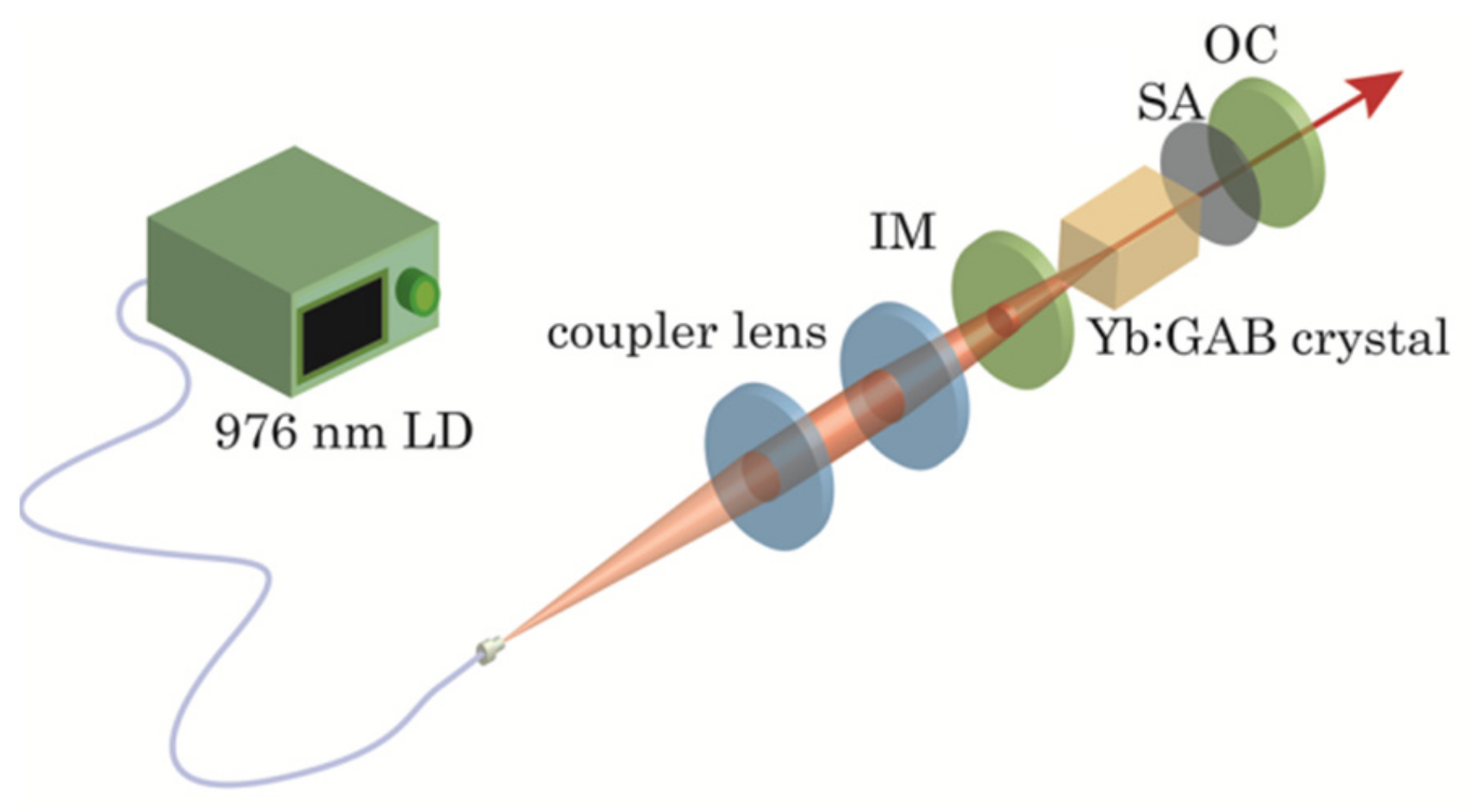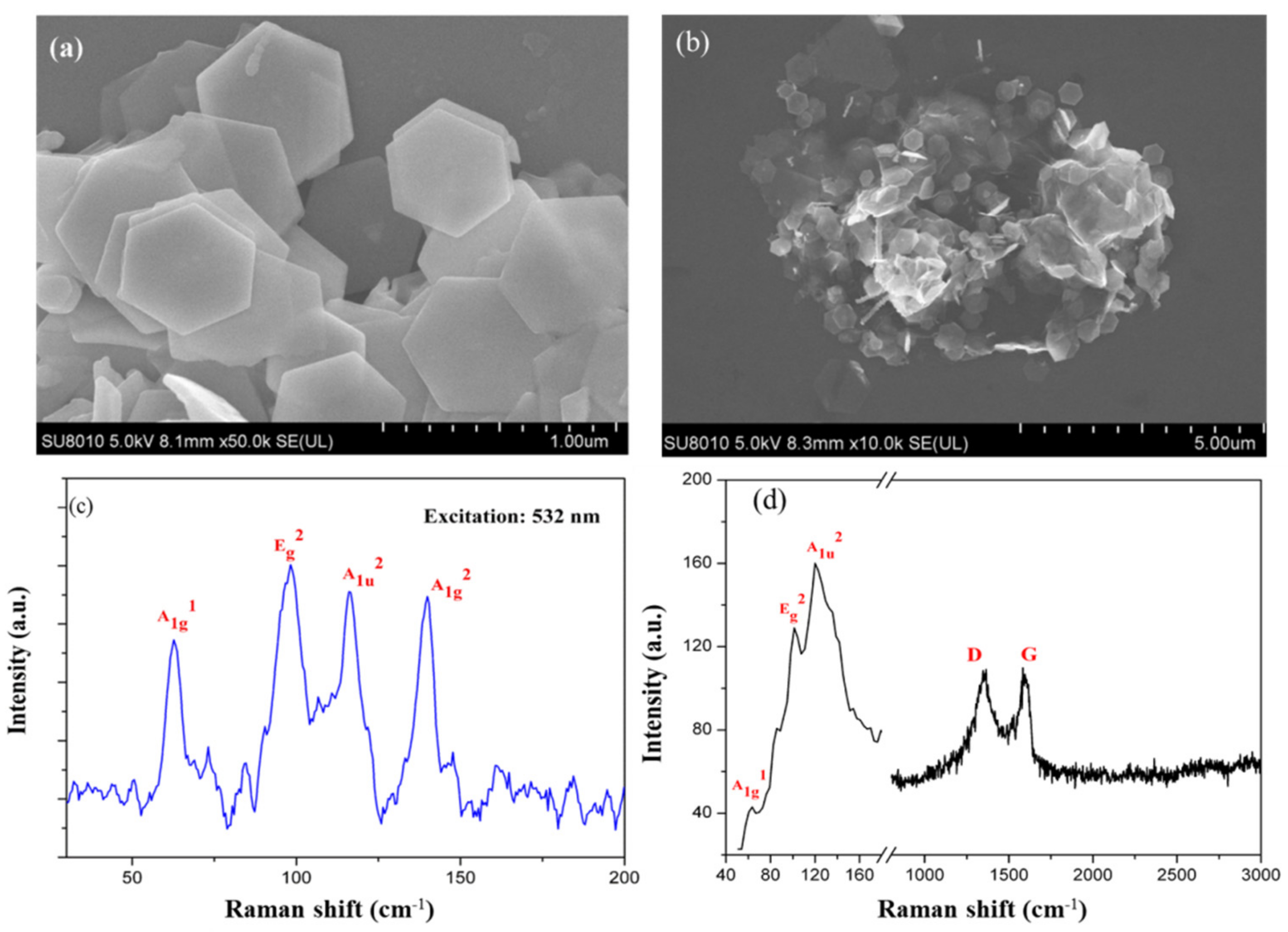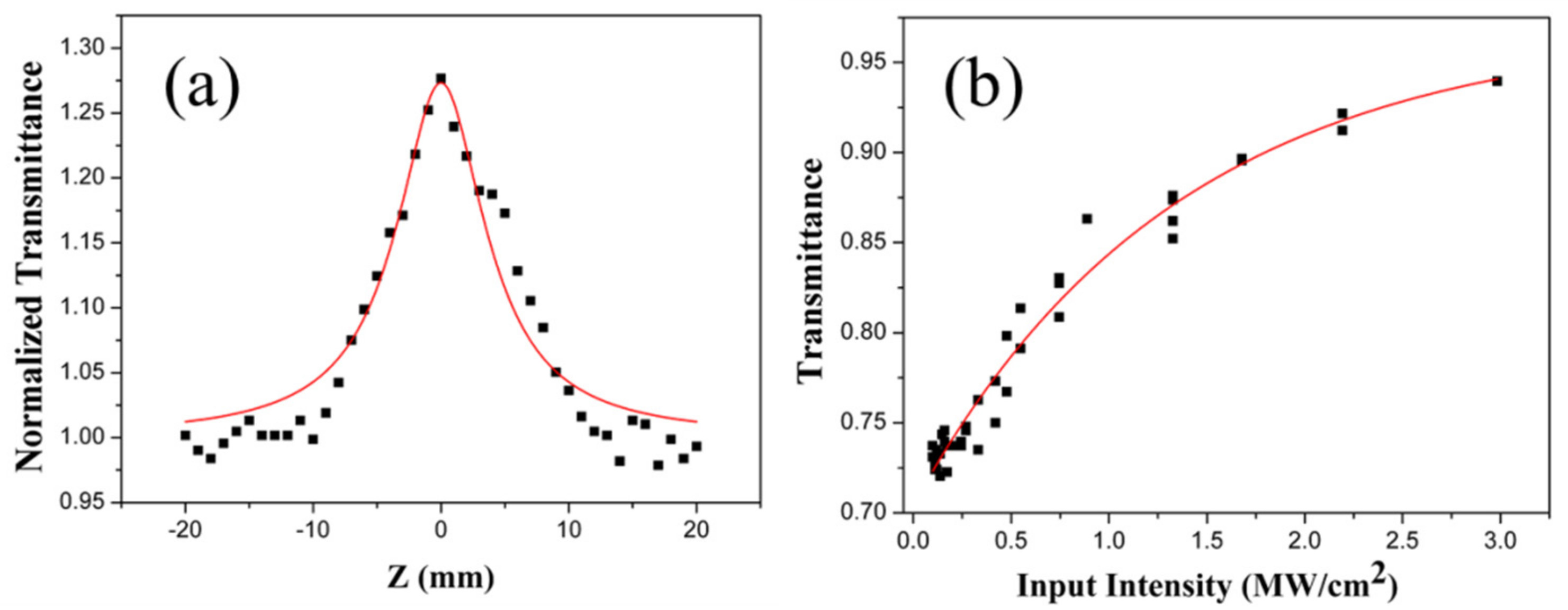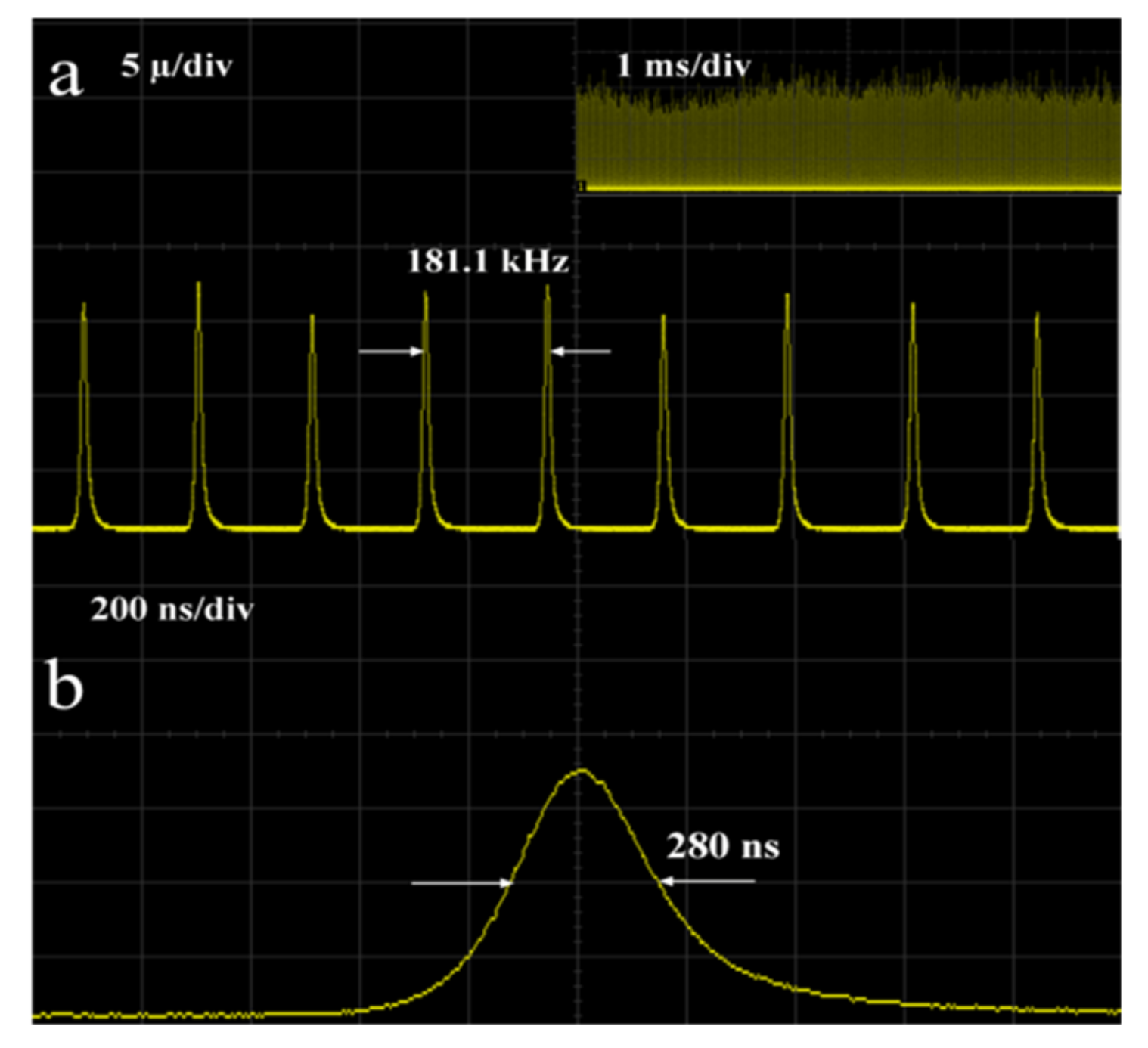Bi2Te3/Graphene Heterostructure as the Saturable Absorber for ~1.0 μm Passively Q-switched Solid State Pulsed Laser
Abstract
:1. Introduction
2. Materials and Methods
3. Results and Discussion
4. Conclusions
Author Contributions
Funding
Data Availability Statement
Conflicts of Interest
References
- Bao, Q.L.; Zhang, H.; Wang, Y.; Ni, Z.H.; Yan, Y.L.; Shen, Z.X.; Loh, K.P.; Tang, D.Y. Atomic-layer graphene as a saturable absorber for ultrafast pulsed lasers. Adv. Funct. Mater. 2009, 19, 3077–3083. [Google Scholar] [CrossRef]
- Serres, J.M.; Loiko, P.; Mateos, X.; Yumashev, K.; Díaz, F. Tm: KLu(WO4)2 microchip laser Q-switched by a graphene-based saturable absorber. Opt. Express 2015, 23, 14108. [Google Scholar] [CrossRef] [PubMed] [Green Version]
- Luo, Z.; Huang, Y.; Weng, J.; Cheng, H.; Xu, H. 1.06 μm Q-switched ytterbium-doped fiber laser using few-layer topological insulator Bi2Se3 as a saturable absorber. Opt. Express. 2013, 21, 29516. [Google Scholar] [CrossRef] [PubMed]
- Liu, X.Y.; Yang, K.J.; Zhao, S.S.; Li, T.Y.; Qiao, W.C.; Zhang, H.; Zhang, B.T.; He, J.; Bian, J.; Zheng, L.M.; et al. High-power passively Q-switched 2 μm all-solid-state laser based on a Bi2Te3 saturable absorber. Photonics Res. 2017, 5, 461. [Google Scholar] [CrossRef] [Green Version]
- Wang, X.H.; Hu, J.Y.; Xu, J.L.; Sun, Y.J.; Xia, H.P.; Tu, C.Y. Sb2Te3 as the saturable absorber for the ~2.0 μm passively Q-switched solid state pulsed laser. RSC Adv. 2019, 9, 29312. [Google Scholar] [CrossRef] [Green Version]
- Luan, C.; Zhang, X.; Zhao, J.; Zhao, S.; Yang, K.; Li, T.; Qiao, W.C.; Chu, H.W.; Qiao, J.P.; Wang, J.; et al. High-peak power passively Q-switched 2 μm laser with MoS2 saturable absorber. IEEE J. Sel. Top. Quantum Electron. 2016, 23, 66. [Google Scholar] [CrossRef]
- Kong, L.C.; Qin, Z.P.; Xie, G.Q.; Guo, Z.N.; Zhang, H. Black phosphorus as broadband saturable absorber for pulsed lasers from 1μm to 2.7 μm wavelength. Laser Phys. Lett. 2016, 13, 045801. [Google Scholar] [CrossRef] [Green Version]
- Nair, R.R.; Blake, P.; Grigorenko, A.N.; Novoselov, K.S.; Booth, T.J.; Stauber, T.; Peres, N.; Geim, A.K. Fine structure constant defnes visual transparency of graphene. Science 2008, 320, 1308. [Google Scholar] [CrossRef] [Green Version]
- Sun, Z.P.; Hasan, T.; Torrisi, F.; Popa, D.; Privitera, G.; Wang, F.Q.; Bonaccorso, F.; Basko, D.M.; Ferrari, A.C. Graphene mode-locked ultrafast laser. ACS Nano 2010, 4, 803–810. [Google Scholar] [CrossRef] [Green Version]
- Wang, Q.; Teng, H.; Zou, Y.W.; Zhang, Z.G.; Li, D.H.; Wang, R.; Gao, C.Q.; Lin, J.J.; Guo, L.W.; Wei, Z.Y. Graphene on SiC as a Q-switcher for a 2 μm laser. Opt. Lett. 2012, 37, 395–397. [Google Scholar] [CrossRef]
- Martinez, A.; Sun, Z. Nanotube and graphene saturable absorbers for fiber lasers. Nat. Photon. 2013, 7, 842–845. [Google Scholar] [CrossRef]
- Chen, S.Q.; Zhao, C.J.; Li, Y.; Huang, H.H.; Lu, S.B.; Zhang, H.; Wen, S.C. Broadband optical and microwave nonlinear response in topological insulator. Opt. Mater. Express. 2014, 4, 587–596. [Google Scholar] [CrossRef]
- Lu, S.B.; Zhao, C.J.; Zou, Y.H.; Chen, S.Q.; Chen, Y.; Li, Y.; Zhang, H.; Wen, S.C.; Tang, D.Y. Third order nonlinear optical property of Bi2Se3. Opt. Express. 2013, 21, 2072–2082. [Google Scholar] [CrossRef] [PubMed]
- Hajlaoui, M.; Papalazarou, E.; Mauchain, J.; Lantz, G.; Moisan, N.; Boschettoet, D.; Jiang, Z.; Miotkowski, I.; Chen, Y.P.; Taleb-Ibrahimi, A.; et al. Ultrafast surface carrier dynamics in the topological insulator Bi2Te3. Nano Lett. 2012, 12, 3532–3536. [Google Scholar] [CrossRef] [Green Version]
- Wang, Y.H.; Hsieh, D.; Sie, E.J.; Steinberg, H.; Gardner, D.R.; Lee, Y.S.; Jarillo-Herrero, P.; Gedik, N. Measurement of intrinsic Dirac fermion cooling on the surface of the topological insulator Bi2Se3 using timeresolved and angle-resolved photoemission spectroscopy. Phys. Rev. Lett. 2012, 109, 127401. [Google Scholar] [CrossRef] [Green Version]
- Glinka, Y.D.; Babakiray, S.; Johnson, T.A.; Bristow, A.D. Ultrafast carrier dynamics in thin-films of the topological insulator Bi2Se3. Appl. Phys. Lett. 2013, 103, 151903. [Google Scholar] [CrossRef] [Green Version]
- Xu, J.L.; Sun, Y.J.; He, J.L.; Wang, Y.; Zhu, Z.J.; You, Z.Y.; Li, J.F.; Chou, M.M.C.; Lee, C.K.; Tu, C.Y. Ultrasensitive nonlinear absorption response of large-size topological insulator and application in low-threshold bulk pulsed lasers. Sci. Rep. 2015, 5, 14856. [Google Scholar] [CrossRef] [Green Version]
- Wang, B.L.; Yu, H.H.; Zhang, H.; Zhao, C.J.; Wen, S.C.; Zhang, H.J.; Wang, J.Y. Topological insulator simultaneously Q-switched dual-wavelength Nd:Lu2O3 laser. IEEE Photon. J. 2014, 6, 1501007. [Google Scholar] [CrossRef]
- Mu, H.R.; Wang, Z.T.; Yuan, J.; Xiao, S.; Chen, C.Y.; Chen, Y.; Song, J.C.; Wang, Y.S.; Xue, Y.Z.; Zhang, H.; et al. Graphene–Bi2Te3 heterostructure as saturable absorber for short pulse generation. ACS Photonics 2015, 2, 832–841. [Google Scholar] [CrossRef]
- Wang, Z.T.; Mu, H.R.; Yuan, J.; Zhao, C.J.; Bao, Q.L.; Zhang, H. Graphene-Bi2Te3 heterostructure as broadband saturable absorber for ultra-short pulse generation in Er-doped and Yb-doped fiber lasers. IEEE J. Sel. Top. Quantum Electron. 2016, 23, 195–199. [Google Scholar] [CrossRef]
- Yu, H.H.; Zhang, H.; Wang, Y.C.; Zhao, C.J.; Wang, B.L.; Wen, S.C.; Zhang, H.J.; Wang, J.Y. Topological insulator as an optical modulator for pulsed solid-state lasers. Laser Photon. Rev. 2013, 7, L77–L83. [Google Scholar] [CrossRef]
- You, Z.Y.; Sun, Y.J.; Sun, D.L.; Zhu, Z.J.; Wang, Y.; Li, J.F.; Tu, C.Y.; Xu, J.L. High performance of a passively Q-switched mid-infrared laser with Bi2Te3/graphene composite SA. Opt. Lett. 2017, 42, 871–874. [Google Scholar] [CrossRef] [PubMed]
- Gao, T.; Huangn, K.; Qi, X.; Li, H.X.; Yang, L.W.; Zhong, J.X. Free-standing SnO2 nanoparticles@graphene hybrid paper for advanced lithium-ion batteries. Ceram. Int. 2014, 40, 6891–6897. [Google Scholar] [CrossRef]
- Maleki-Ghaleh, H.; Siadati, M.H.; Fallah, A.; Koc, B.; Kavanlouei, M.; Khademi-Azandehi, P.; Moradpur-Tari, E.; Omidi, Y.; Barar, J.; Beygi-Khosrowshahi, Y.; et al. Antibacterial and Cellular Behaviors of Novel Zinc-Doped Hydroxyapatite/Graphene Nanocomposite for Bone Tissue Engineering. Int. J. Mol. Sci. 2021, 22, 9564. [Google Scholar] [CrossRef]
- Luo, T.; Chen, X.C.; Wang, L.; Wang, P.; Li, C.C.; Iqbal, S.; Cao, B.Q. Ultrafast synthesis of SiC@graphene nanocomposites by one-step laser induced fragmentation and decomposition. Ceram. Int. 2018, 44, 19028–19032. [Google Scholar] [CrossRef]
- Dargahi, Z.; Asgharzadeh, H.; Maleki-Ghaleh, H. Synthesis of Mo-doped TiO2/reduced graphene oxide nanocomposite for photoelectrocatalytic applications. Ceram. Int. 2018, 44, 13015–13023. [Google Scholar] [CrossRef]
- Ju, H.; Kim, M.; Kim, J. A facile fabrication of n-type Bi2Te3 nanowire/graphene layer-by-layer hybrid structures and their improved thermoelectric performance. Chem. Eng. J. 2015, 275, 102–112. [Google Scholar] [CrossRef]
- Tu, F.F.; Xie, J.; Cao, G.S.; Zhao, X.B. Self-assembly of Bi2Te3-nanoplate/Graphene-nanosheet hybrid by one-pot route and its improved Li-storage properties. Materials 2012, 5, 1275–1284. [Google Scholar] [CrossRef] [Green Version]
- Shahil, K.M.F.; Hossain, M.Z.; Teweldebrhan, D.; Balandin, A.A. Crystal symmetry breaking in few-quintuple Bi2Te3 films: Applications in nanometrology of topological insulators. Appl. Phys. Lett. 2010, 96, 153103. [Google Scholar] [CrossRef] [Green Version]
- Zhao, Y.M.; Zhao, Y.; Hughes, R.W.; Su, Z.; Zhou, W.; Gregory, D.H. One-step synthesis of bismuth telluride nanosheets of a few quintuple layers in thickness. Angew. Chem. Int. Ed. 2011, 50, 10397–10401. [Google Scholar] [CrossRef]
- Ma, J.; Lu, S.B.; Guo, Z.N.; Xu, X.D.; Zhang, H.; Tang, D.Y.; Fan, D.Y. Few-layer black phosphorus based saturable absorber mirror for pulsed solid-state lasers. Opt. Exp. 2015, 23, 22643–22648. [Google Scholar] [CrossRef] [PubMed]
- Lan, J.C.; Qiao, J.; Sung, W.H.; Chen, C.H.; Jhang, R.H.; Lin, S.H.; Ng, L.R.; Liang, G.; Wu, M.Y.; Tu, L.W. Role of carrier-transfer in the optical nonlinearity of graphene/Bi2Te3 heterojunctions. Nanoscale 2020, 12, 16956–16966. [Google Scholar] [CrossRef]
- Sun, Y.J.; Lee, C.K.; Wang, Y.; Xia, H.P.; Wang, X.H.; You, Z.Y.; Tu, C.Y.; Xu, J.L. Passively Q-Switched Wavelength-Tunable Bulk Laser Using Topological Insulator at 1 μm. IEEE Photon. Technol. Lett. 2016, 28, 2764–2767. [Google Scholar] [CrossRef]
- Lou, F.; Zhao, L.W.; He, J.L.; Jia, Z.T.; Su, X.C. Nanosecond-pulsed, dual-wavelength, passively Q-switched ytterbium-doped bulk laser based on few-layer MoS2 saturable absorber. Photon. Res. 2015, 3, A25–A29. [Google Scholar] [CrossRef]
- Hu, M.T.; Lin, J.H.; Tian, J.R.; Dou, Z.Y.; Song, Y.R. Generation of Q-switched pulse by Bi2Se3 topological insulator in Yb: KGW laser. Laser Phys. Lett. 2014, 11, 115806. [Google Scholar] [CrossRef]
- Sun, Y.J.; Lee, C.K.; Xu, J.L.; Zhu, Z.J.; Wang, Y.Q.; Gao, S.F.; Xia, H.P.; You, Z.Y.; Tu, C.Y. Passively Q-switched tri-wavelength Yb3+:GdAl3(BO3)4 solid-state laser with topological insulator Bi2Te3 as saturable absorber. Photon. Res. 2015, 3, A97–A101. [Google Scholar] [CrossRef] [Green Version]






| Type of SAs | Modulation Depth | Saturation Intensity | Nonsaturable Loss | Ref. |
|---|---|---|---|---|
| Monolayer graphene | 4.5% | 0.8 MW/cm2 | - | [32] |
| 6.5 nm Bi2Te3 | 6.5% | 35 W/cm2 | - | |
| Bi2Te3/grapheme(CVD) | 23% | 0.6 MW/cm2 | - | |
| Bi2Te3 | 14.29% | 16.62 kW/cm2 | 4.23% | [33] |
| Bi2Te3/graphene | 26.5% | 1.34 MW/cm2 | 3.1% | This work |
| Type of SAs | Gain Crystal | Output Power (mw) | Pulse Width (ns) | Repetition Rate (kHz) | Pulse Energy (μJ) | Ref. |
|---|---|---|---|---|---|---|
| Bi2Te3 | Nd: Lu2O3 | 79 | 720 | 94.7 | 0.83 | [18] |
| BP | Yb: CYA | 37 | 620 | 113.6 | 0.33 | [31] |
| MoS2 | Nd: YAP | 260 | 227 | 232.5 | 1.11 | [34] |
| Bi2Se3 | Yb: KGW | 439.4 | 1600 | 166.7 | 2.64 | [35] |
| Bi2Te3 | Yb: CYB | 161 | 416 | 147.7 | 1.09 | [33] |
| Bi2Te3 | Yb: GAB | 57 | 415 | 111.4 | 0.51 | [36] |
| Bi2Te3/graphene | Yb: GAB | 305 | 280 | 181.1 | 1.83 | This work |
Publisher’s Note: MDPI stays neutral with regard to jurisdictional claims in published maps and institutional affiliations. |
© 2022 by the authors. Licensee MDPI, Basel, Switzerland. This article is an open access article distributed under the terms and conditions of the Creative Commons Attribution (CC BY) license (https://creativecommons.org/licenses/by/4.0/).
Share and Cite
Sun, Y.; Xia, H. Bi2Te3/Graphene Heterostructure as the Saturable Absorber for ~1.0 μm Passively Q-switched Solid State Pulsed Laser. Crystals 2022, 12, 222. https://doi.org/10.3390/cryst12020222
Sun Y, Xia H. Bi2Te3/Graphene Heterostructure as the Saturable Absorber for ~1.0 μm Passively Q-switched Solid State Pulsed Laser. Crystals. 2022; 12(2):222. https://doi.org/10.3390/cryst12020222
Chicago/Turabian StyleSun, Yijian, and Houping Xia. 2022. "Bi2Te3/Graphene Heterostructure as the Saturable Absorber for ~1.0 μm Passively Q-switched Solid State Pulsed Laser" Crystals 12, no. 2: 222. https://doi.org/10.3390/cryst12020222
APA StyleSun, Y., & Xia, H. (2022). Bi2Te3/Graphene Heterostructure as the Saturable Absorber for ~1.0 μm Passively Q-switched Solid State Pulsed Laser. Crystals, 12(2), 222. https://doi.org/10.3390/cryst12020222






